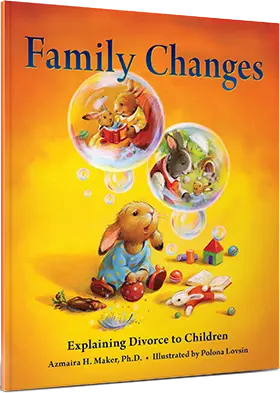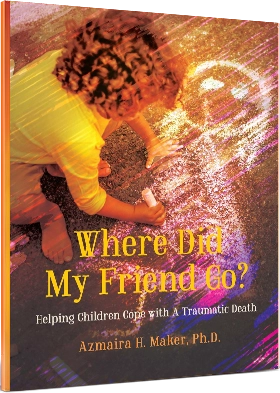Our Book Community
Dr. Azmaira H. Maker is a licensed clinical psychologist, author, and speaker who received her doctoral and post-doctoral training at University of Michigan, and has been working with children, parents, and families for twenty years. She brings a wealth of experience working with divorcing families to Family Changes, which is certain to educate and empower children and parents.

FAMILY CHANGES
Explaining Divorce to Children
Family Changes is a picture storybook that focuses on a non-traumatic separation and divorce between a heterosexual couple. The content assists parents and other significant adults (grandparents, teachers, therapists, and caregivers) to process factual and emotional information with young children, ages 4-8 years.


WHERE DID MY FRIEND GO?
A Children’s Book About Death
Without the right guidance, death can be a very confusing and overwhelming concept for a child to grasp. As parents, grandparents, and guardians, it is our duty to understand how to explain death to children in a healthy, honest, and responsible way as it will lay the foundation of their relationship with the concept.

The story touches on several key issues that children worry about - will their parents still love them, will they have two homes now, did they somehow cause the divorce, etc. The book also opens with a straightforward Note to Adults and ends with a list of questions that adults can discuss with children. Often books that do a good job of explaining divorce and separation are so focused on the child's point-of-view, that they don't offer any advice for the parents, caregivers, and teachers that are trying to help the child makes sense of it all. Family Changes avoids that problem and gives good guidelines for adults. I would recommend this book to parents and other family members, educators, and counselors.
CNetGalley Reviews/The Fairview Review - Librarian
Based on the typical emotional turbulence a child feels from separation or divorce, Family Changes receives high recommendation as the first title that adults should turn to in the effort to explain, explore, and support a child's feelings in the matter, concluding with a list of 'process questions' which adults can use to further enhance the story line's overall approach.
CA Bookwatch/Donovan’s Literary Services/Recommended Reading
This story is filled with little moments that reflect the nature of children perfectly. If you need to explain what it means to be divorced or separated to your child then this is one of the best ways to do that. The book is filled with relatable emotions and questions that a lot of children will have if their family is going through a separation. Dr. Maker’s years of experience are evident in the story as she masterfully addresses many common concerns for children experiencing a divorce in their family.
The Littlest Bookshelf
Exceptional, impressive, thoroughly 'kid friendly' from beginning to end, "Family Changes: Explaining Divorce to Children" should be a part of every community library Parenting Studies collections. For families with young children who are having to deal with divorce, "Family Changes: Explaining Divorce to Children" will prove to be an invaluable and instructive aid.
Editor in Chief - Midwest Book Review
Those of us parenting, working with, or caring for children experiencing divorce will welcome Family Changes as a unique, positive, and creative resource for helping children understand and cope with this complicated transition. The comprehensive note to adults effectively explains how children work through painful questions and feelings. The touching story — with the endearing Zoey and her attempt to understand a very grown up topic — ends with extremely helpful follow up questions that will be highly valued by parents, child advocates, therapists, and others who wish to better serve children during this difficult time. I highly recommend this book to parents and professionals.
Sacha Coupet, Ph.D., J.D. Clinical Psychologist and Associate Professor of Family Law, Loyola University, Chicago, IL
Family Changes: Explaining Divorce to Children is an outstanding book that is gentle, positive, and validating for both children and adults. With an excellent and informative parent guide about the value of talking to children about their feelings, a highly sensitive and engaging story with exquisite illustrations, and an effective list of questions that children typically ask, this book is essential reading for divorcing families, and for therapists and advocates working with children of divorce.
Sandra A. Graham-Bermann, Ph.D., Professor of Psychology and Psychiatry, University of Michigan
Family Changes is an inspiring and exceptional book on divorce. It explains divorce in a developmentally appropriate and comforting language that validates children's complex feelings about divorce. Dr. Maker's expertise and years of experience working with children who are coping with the grief and confusion that often accompany divorce shine through in every page. I highly recommend this book to divorcing parents, schools, libraries, and professionals working with children of divorce.
Martha Crowe, M.A. Child Development, Institute for Public Health, San Diego State University, CA
Dr. Maker has brought us this excellent child-centric educational book about how to navigate the changes of a family undergoing divorce. Dr. Maker takes us through this experience from the child's point of view and shares the gift of positive transformation that can occur during this life-changing time. The illustrations are sublime and the topic is handled so gently and ingeniously. Of course, it is written by a child psychologist with the gift of creativity. It's a book that every child therapist, library, school, and families going through a divorce should have on their shelves.
Krista Royabal, M.D., Psychiatrist, Executive Medical Director, True Life Center for Wellbeing, CA
Upcoming Books
After her debut children’s book, Family Changes: Explaining Divorce to Children Dr. Azmaira H. Maker is happily moving forward with a number of books to help open communication and understanding between parents and children. Some conversations are difficult, and figuring out where to begin doesn’t always come easy. Dr. Maker is hopeful that these stories, founded in well-established theory, research, and clinical expertise, will help families find an easier path to open communication.